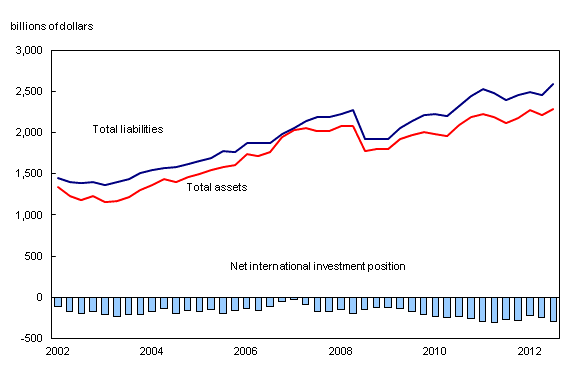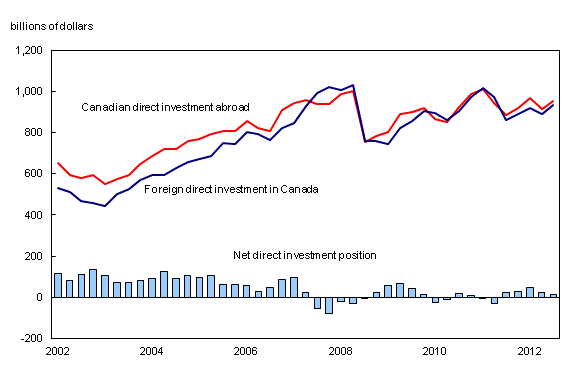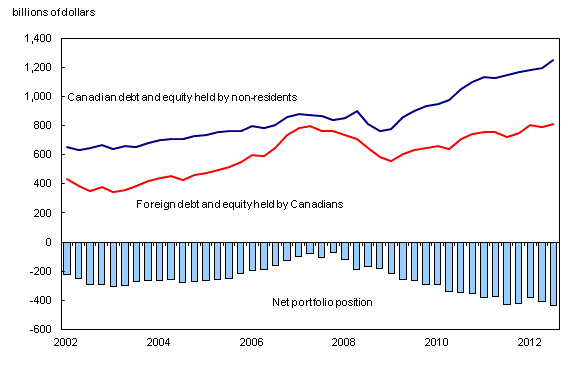Canada's international investment position, third quarter 2012
Archived Content
Information identified as archived is provided for reference, research or recordkeeping purposes. It is not subject to the Government of Canada Web Standards and has not been altered or updated since it was archived. Please "contact us" to request a format other than those available.
Related subjects
-
[an error occurred while processing this directive]
Canada's net foreign debt increased by $53.7 billion to $296.6 billion at the end of the third quarter. This mainly reflected the effect of the appreciation of the Canadian dollar on foreign currency denominated assets as well as increased borrowing from abroad in the quarter.
Canada's international investment position

Chart description: Canada's international investment position
International assets buoyed by stock market gains, moderated by a stronger Canadian dollar
Canada's international assets advanced $72.8 billion to $2,290.3 billion in the third quarter. Higher foreign stock markets and increased Canadian acquisitions of foreign assets ($51.8 billion) in the quarter accounted for the increase. However, the effect of the appreciation of the Canadian dollar against most major currencies reduced the value of foreign currency denominated international assets by $56.9 billion in the quarter. The Canadian dollar gained 3.5% against the US dollar, 2.0% against the Euro, 1.0% against the Japanese yen and 0.5% against the British pound.
International liabilities up on continued investment from abroad and stock market gains
Non-residents invested $74.0 billion in the Canadian economy in the third quarter, as Canada's international liabilities increased by $126.5 billion to $2,586.9 billion. Canadian stock market gains also added $63.0 billion to the value of non-resident holdings of Canadian equities, as the Toronto Stock Exchange rose 6.2%. However, exchange rate movements dampened the overall increase in international liabilities, as a result of downward revaluations (-$20.1 billion) of foreign currency denominated Canadian liabilities.
Canada's net asset position on direct investment declines
Canada's net asset position on direct investment declined further in the third quarter, as the increase in foreign direct investment in Canada exceeded that of Canadian direct investment abroad.
Canadian direct investment abroad increased $39.5 billion to $951.9 billion by quarter end. Higher prices on international stock markets and investment outflows added $44.3 billion and $19.1 billion, respectively, the latter reflecting increased mergers and acquisitions activity. However, the increase was partly offset by the revaluation effect of the appreciation of the Canadian dollar on these foreign currency denominated assets.
On the other side of the ledger, the value of foreign direct investment in Canada advanced $45.9 billion to $936.0 billion. This reflected strengthened Canadian equity markets supported by direct investment inflows of $8.4 billion in the quarter.
Direct investment position

Chart description: Direct investment position
Canada's net liability position on securities widens further
Canadian holdings of foreign securities were up $21.6 billion, led by capital gains on equities. This increase was constrained by the downward revaluation of these foreign currency denominated securities. Canadian investors held $811.5 billion of foreign securities by the end of the third quarter, with 79% in the form of equities.
Portfolio investment position

Chart description: Portfolio investment position
Sustained Canadian borrowing from non-residents, coupled with Toronto Stock Exchange gains in the third quarter, accounted for most of the $53.9 billion increase in the value of foreign holdings of Canadian securities. Of the $1,248.5 billion of Canadian securities held by non-residents, 65% ($806.5 billion) was in the form of debt instruments. Non-residents have accumulated an increasing proportion of government debt since the first quarter of 2009, especially federal government debt. As a result, the share of federal government bonds plus short-term paper held by non-residents more than doubled from 13% in the fourth quarter of 2008 to 29% by the end of the third quarter of 2012.
Note to readers
The main measure of the international investment position accounts now incorporates market valuation for tradable securities and foreign direct investment equity. This presentation adds a further dimension to the analysis of Canada's net international investment position and more accurately reflects changes in that position. The international investment position at book value is still available, as the link to the annual foreign direct investment release includes geographical and industry details. For more information, see Valuation of assets and liabilities .
Definition
The international investment position presents the value and composition of Canada's assets and liabilities to the rest of the world. Canada's net international investment position is the difference between these foreign assets and liabilities. The excess of international liabilities over assets can be referred to as Canada's net foreign debt; the excess of international assets over liabilities can be referred to as Canada's net foreign assets.
Currency valuation
The value of assets and liabilities denominated in foreign currency are converted to Canadian dollars at the end of each period for which a balance sheet is calculated. Most of Canada's foreign assets are denominated in foreign currencies while less than half of Canada's international liabilities are in foreign currencies. When the Canadian dollar is appreciating in value, the restatement of the value of these assets and liabilities in Canadian dollars lowers the recorded value. The opposite is true when the Canadian dollar is depreciating.
Available without charge in CANSIM: tables CANSIM table376-0059, CANSIM table376-0142 and CANSIM table376-0144.
Definitions, data sources and methods: survey numbers survey number1534 and survey number1537.
For more information, or to enquire about the concepts, methods or data quality of this release, contact us (toll-free 1-800-263-1136; infostats@statcan.gc.ca) or Media Relations (613-951-4636; statcan.mediahotline-ligneinfomedias.statcan@canada.ca).
- Date modified:
